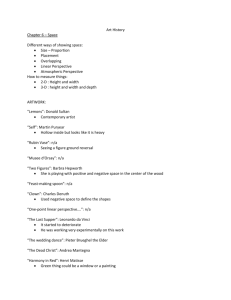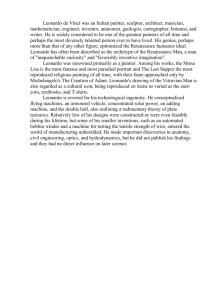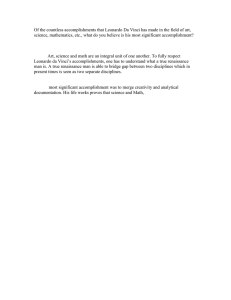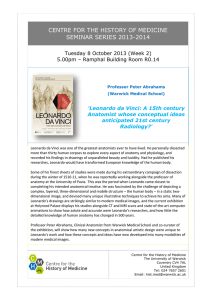LEONARDO DA VINCI AND THE ORIGIN OF SEMEN 1Balliol
advertisement
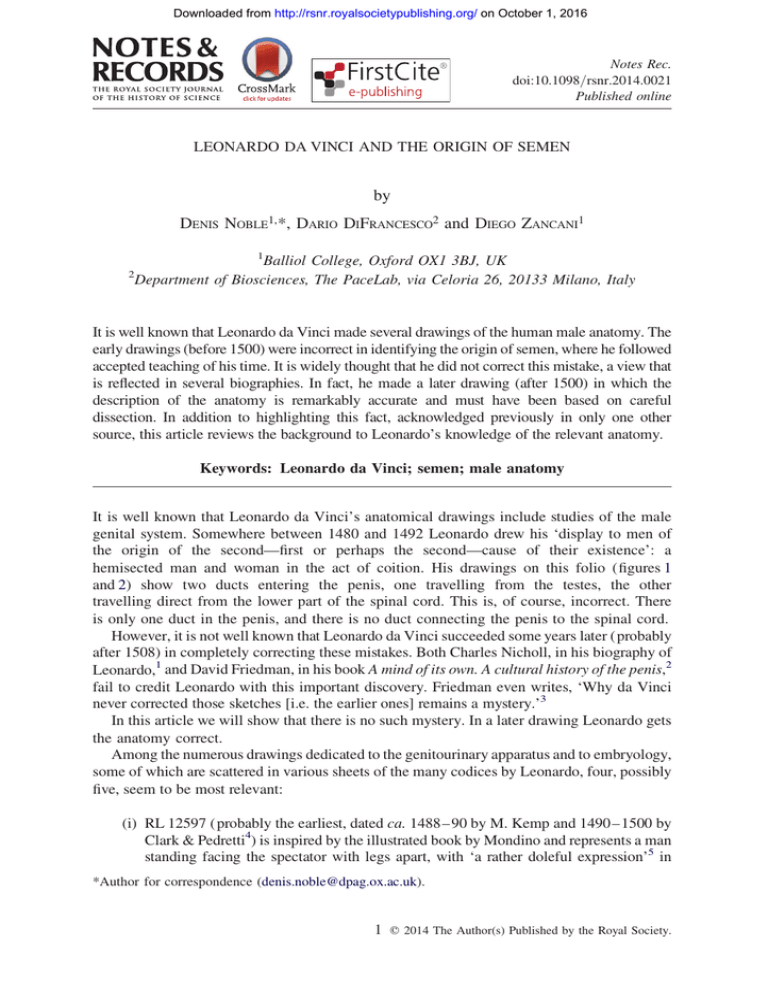
Downloaded from http://rsnr.royalsocietypublishing.org/ on October 1, 2016 Notes Rec. doi:10.1098/rsnr.2014.0021 Published online LEONARDO DA VINCI AND THE ORIGIN OF SEMEN by DENIS NOBLE1, *, DARIO DIFRANCESCO2 and DIEGO ZANCANI1 1 2 Balliol College, Oxford OX1 3BJ, UK Department of Biosciences, The PaceLab, via Celoria 26, 20133 Milano, Italy It is well known that Leonardo da Vinci made several drawings of the human male anatomy. The early drawings (before 1500) were incorrect in identifying the origin of semen, where he followed accepted teaching of his time. It is widely thought that he did not correct this mistake, a view that is reflected in several biographies. In fact, he made a later drawing (after 1500) in which the description of the anatomy is remarkably accurate and must have been based on careful dissection. In addition to highlighting this fact, acknowledged previously in only one other source, this article reviews the background to Leonardo’s knowledge of the relevant anatomy. Keywords: Leonardo da Vinci; semen; male anatomy It is well known that Leonardo da Vinci’s anatomical drawings include studies of the male genital system. Somewhere between 1480 and 1492 Leonardo drew his ‘display to men of the origin of the second—first or perhaps the second—cause of their existence’: a hemisected man and woman in the act of coition. His drawings on this folio (figures 1 and 2) show two ducts entering the penis, one travelling from the testes, the other travelling direct from the lower part of the spinal cord. This is, of course, incorrect. There is only one duct in the penis, and there is no duct connecting the penis to the spinal cord. However, it is not well known that Leonardo da Vinci succeeded some years later ( probably after 1508) in completely correcting these mistakes. Both Charles Nicholl, in his biography of Leonardo,1 and David Friedman, in his book A mind of its own. A cultural history of the penis,2 fail to credit Leonardo with this important discovery. Friedman even writes, ‘Why da Vinci never corrected those sketches [i.e. the earlier ones] remains a mystery.’3 In this article we will show that there is no such mystery. In a later drawing Leonardo gets the anatomy correct. Among the numerous drawings dedicated to the genitourinary apparatus and to embryology, some of which are scattered in various sheets of the many codices by Leonardo, four, possibly five, seem to be most relevant: (i) RL 12597 ( probably the earliest, dated ca. 1488–90 by M. Kemp and 1490–1500 by Clark & Pedretti4) is inspired by the illustrated book by Mondino and represents a man standing facing the spectator with legs apart, with ‘a rather doleful expression’5 in *Author for correspondence (denis.noble@dpag.ox.ac.uk). 1 q 2014 The Author(s) Published by the Royal Society. Downloaded from http://rsnr.royalsocietypublishing.org/ on October 1, 2016 2 D. Noble and others Figure 1. Leonardo da Vinci’s drawing of hemisected man and woman in coition. (From folio RL 19097v, by permission of Royal Collection Trust; copyright q 2014 Her Majesty Queen Elizabeth II.) (Online version in colour.) (ii) (iii) (iv) (v) which the ‘physiology and morphology of the vascular system stands entirely within the tradition of the great Greek anatomist Galen.’6 Weimar, Schlossmuseum, recto ca. 1506– 08. Originally part of MS B at Windsor. RL 19095v Comparison of male and female generative organs (Leonardo’s notes are particularly relevant). RL 19097v Drawing of coition. RL 19098v, bladder and testicles. Downloaded from http://rsnr.royalsocietypublishing.org/ on October 1, 2016 Leonardo da Vinci and the origin of semen 3 Figure 2. The relevant part of RL 19097 showing two tubes in longitudinal and cross sections of the penis. (From folio RL 19097v, by permission of Royal Collection Trust; copyright q 2014 Her Majesty Queen Elizabeth II.) (Online version in colour.) THE FIRST DRAWING Leonardo’s first drawing may represent views that influenced European thought at that time. These included the idea that there was direct connection from the nervous system, from the brain through the spinal cord, to the penis, perhaps so that an essential component of the male seed, presumably originating in the brain, could be transmitted during intercourse. These ideas were not only common in the West, they were also widely held in East Asia. The ancient Chinese sex manuals frequently referred to the origin of semen7 and in many cases referred specifically to the nervous system as the route by which the transmission of the relevant characteristics of semen was achieved. This idea was also important to the ancient Taoists because they also believed that it was beneficial to a man to preserve his semen and return it to the brain. The social, religious and medical interpretations were very different, however, and that question deserves a deeper study than we have done so far. With this brief background we can interpret Leonardo’s first drawings (figures 1 and 2). They clearly show several branches from the lower spinal cord fusing to form a duct that runs all the way through to the tip of the penis. There is also a tube (?) running all the way from the chest. Finally there are ducts connecting the testes to the penis. There is some ambiguity in the drawing since the testes seem to connect to a duct system that includes a duct sweeping backwards to circle the bladder before returning to enter the penis. Downloaded from http://rsnr.royalsocietypublishing.org/ on October 1, 2016 4 D. Noble and others However we interpret the complete duct system in the drawing, there are clearly two ducts represented in the penis. To emphasize this, longitudinal and cross sections of the penis on the same sheet show two ducts (figure 2). When he made the drawings on this sheet, Leonardo was already modifying the main received ideas. Kenneth Keele notes that at the centre of this sheet Leonardo writes, ‘Note what the testicles have to do with the coition and the sperm’ and he specifically distances himself from Avicenna: ‘Here Avicenna claims that the soul begets the soul and body; the body consists of every used member’8 (see Appendix 1 for the relevant translations of the Italian text). He also correctly shows one of the ducts looping back from the testes before entering the penis. So, he understood that the pathway of this duct did not follow a direct (i.e. the shortest) route to the penis. This detail is also shown very clearly on sheet RL 19105v, where he shows tubes leaving the testes to course back to what are presumably the seminal vesicles before swinging forward again to enter the penis. In these smaller sketches no connections are shown to the spinal cord. LEONARDO’S LATER DRAWING OF THE MALE GENITAL ANATOMY Some time probably after 1508, Leonardo produced the drawing that can be interpreted as his claim to have solved the problem. It must have been based on careful dissection because all the main features of the human male anatomy are correct. He shows the course of the vas deferens arising from the testicles, then passing backwards around the bladder to enter the seminal vesicles towards the back (this was already shown in the earlier smaller sketches), from which the ejaculatory duct is correctly shown coursing through the perineal region and entering the urethra just beyond the internal sphincter of the bladder to form a single duct within the penis. Figure 3 shows this drawing, and the legend describes how accurately this corresponds to modern anatomical knowledge. THE HISTORICAL AND BIBLIOGRAPHIC BACKGROUND: WHAT DID LEONARDO KNOW, AND WHO INFLUENCED HIM? The drawings RL 1261v, K/P 1r, as well as the figure of coitus RL 19097v, K/P 35r, seem to belong to the Milan period ca. 1485 –95, restricted to ca. 1490 in Zöllner and Nathan,10 whereas some drawings of the male genitalia with spermatic ducts seem to be later, and are generally dated to ca. 1508/09 (e.g. RL 19098 and 19099).11 Italian scholars seem to emphasize that Leonardo’s interest for the seat of the virtù generativa was due to the fact that he believed this to be one of the ‘soul’s faculties’. Although Giorgio Vasari mentions the collaboration between Leonardo and Marco Antonio della Torre (1481 – 1511),12 professor of Anatomy at Padua and at Pavia University around 1511, it is unlikely that Leonardo drew on the professor’s knowledge of anatomy for his own drawings, preferring to rely on dissections. However, we know that Leonardo possessed some anatomy treatises. Among the numerous manuscripts left by Leonardo, scholars have found two lists of books belonging to the artist, and probably written at different times. Like all similar lists, including inventories, many texts are mentioned in an abbreviated form and it is Downloaded from http://rsnr.royalsocietypublishing.org/ on October 1, 2016 Leonardo da Vinci and the origin of semen 5 Figure 3. Leonardo’s later drawing showing the correct anatomy. All of the following items of modern anatomy are identifiable in Leonardo’s drawings. ‘The testes are correctly shown contained within a fluid-filled cavity; the vas deferens rises from the testicle, loops over the top of the pubic bone, . . .. . . .and passes into the upper end of the seminal vesicle. The ejaculatory duct runs from the lower end of the seminal vesicle to join the urethra just below the bladder. Leonardo shows the urethra as the sole channel of the penis, and any notion that a ‘spiritual’ component is carried in a second channel from the spinal cord [compare figures 1 and 2] has been abandoned.’9 (From folio RL 19098v, by permission of Royal Collection Trust; copyright q 2014 Her Majesty Queen Elizabeth II.) (Online version in colour.) therefore sometimes difficult to identify exactly which book is being referred to (most of them printed rather than manuscript, and most in Italian rather than Latin).13 The first list, which contains 40 items, was found in the Codex Atlanticus, which is now in the Biblioteca Ambrosiana in Milan, on folio 210 recto.a. The second list, of well over 100 items, is contained in the Madrid manuscript 8936, on one page, ff. 2 – 3, but some references to books probably owned by Leonardo are also scattered in other manuscripts, some of which were discovered relatively recently. In the oldest list there are no obvious items referring to anatomy, although there is mentioned a book Della conservatione della sanità [On the preservation of health], which could refer to a variety of early printed texts, among which are Ugo Benzi’s Tractato utilissimo circa la conservazione de la sanitade (Milan, 1481) and Antonius Gazius’s De conservatione sanitatis (Venice, 1491). The second list, probably compiled around 1503 – 04, contains various books on medicine and on anatomy in particular, namely a Fasciculu medicine, latino which can easily be identified with a compilation attributed to John Ketham, Fasciculus medicine in quo continentur [. . .], published in Venice in 1491 and 1494 – 95 (there is a copy in the Bodleian Library), containing aphorisms and the anatomical work of Mondino de’ Liucci, or Luzzi, a celebrated physician from Bologna (ca. 1270– 1326), quoted by Leonardo on various occasions in the Windsor manuscripts. Some treatises on surgery, medicine and specifically the Tractatus de urinarum iudiciis by Bartolomeo Montagnana, published in Padua (1487), are all mentioned, as well as one ‘Anatomy book’ (Libro di notomia) which is likely to refer to the Anatomice sive historia Downloaded from http://rsnr.royalsocietypublishing.org/ on October 1, 2016 6 D. Noble and others corporis humani libri V, by Alessandro Benedetti (Venice, 1498 (?), 1502 and numerous other editions), because Leonardo mentions this author in his Manuscript F, on the inside of the cover among other treatises [. . .] vetruuio / meteura / archimede de centru gravitates / anatomja alessandro benedetto [. . .].14 Therefore it is likely that the two books specifically on anatomy that Leonardo owned were the one by Mondino and the one by Alessandro Benedetti (ca. 1450 – 1525), professor of anatomy at Padua University.15 In the text by Mondino, contained in the quoted Fasciculus, we find two passages concerning spermatic ducts. The first is De diversis vasis spermaticis, in which he declares ‘vasa spermatica sunt duo, emittunt sperma quod apportatur a testiculis, quod ab eis generatum fuit in aliis vasis, et illud sperma emittunt in canale virge’ [‘There are two spermatic ducts, they let off sperm which comes from the testicles, which was generated in other vessels, and they emit such sperm in the canal of the penis’]. In an additional chapter on the spermatic ducts and their differences in men and women, Mondino declares, quoting Avicenna (Can. Sen. xx and xxi, ‘de anathomia matricis’) that ‘in viris et mulieribus oriunt iuxta renes’ [‘in both men and women the spermatic ducts originate near the kidneys’]. IDEAS ON THE ORIGIN OF SEMEN The problem of the origin of human fluids had exercised ancient medicine for a long time, and numerous texts seem to agree on the provenance of semen from ‘near the spine’ or ‘near the kidneys’. It is only in the treatise by Alessandro Benedetti that we find a more specific origin, attributed to Galen. Benedetti mentions in Book II, ch. XVI [f. 21r], ‘De renibus’ [‘On the kidneys’]: [. . .] rami venae maioris in sinus renum non deriuant, sed capitibus potius adhaerescunt & cauum non subeunt, verum in corpus eorum absumuntur, sicut et, ahorta. Ex quibus genitale semen magna ex parte generatur. [The branches of the major vein [vena cava or vena chilis] do not pass into the folds of the kidneys but rather adhere with their heads and do not enter the hollow part but disappear in the body of the kidney, just as the aorta does. From these kidneys the genital semen is generated in large part.]16 In chapter XVII [f. 21v], ‘De venis seminarijs’ [‘On the seminal veins’], Benedetti states: Seminariae venae geminae ad capita testium a renibus deueniunt, pori dicti, sanguinolenti, totidemque arteriae de vena ahorta exangues pretenduntur, nam in coitu spiritus, semen antecedit, quo procul per saltus propellitur. [Two seminal [spermatic] veins come from the kidneys to the heads of the testicles. They are called ducts, or pores, and are bloody. Two bloodless arteries [spermatic] stretch forth from the aorta vein, for in coitus spirit [air] precedes the semen; by means of the spirit the semen is propelled in spurts.] This view seems to derive from Hippocrates (Opera, III, 748). But the most relevant passage for Leonardo’s anatomical drawings comes in chapter XVIII [f. 22r], ‘De semine’ [‘On the semen’]: which is worth quoting at least in part: Semen corporis peruacaneum alimentum est, quod principalium membrorum materia pura atque absoluta est, generationis necessaria. Nam et maior geniturae quantitas ex cerebro (Galeno teste) diduci creditur, ob id salacissimo cuidam, dissecto post funus Downloaded from http://rsnr.royalsocietypublishing.org/ on October 1, 2016 Leonardo da Vinci and the origin of semen 7 capite, cerebri exiguum repertum est. Venae enim quae vltra aures ferunt, si aduruntur vel secantur, sterilitatem induci miro atque secreto naturae limite [. . .]. [The semen is a superfluous nourishment of the body, a material pure and separate from the principal members necessary for generation. The greater quantity of the material of generation, it is believed on the authority of Galen [Galeno teste], is drawn from the brain. For this reason a certain very lecherous man whose head was dissected after his death was found to have a very little brain. The veins which pass behind the ears, if cauterised or cut, induce sterility [. . .].] The reference to Galen is identified by R. L. Lind as actually coming from the Pseudo Galen, Definitiones Medicae (vol. XIX, K. 449), who quotes Plato and Diocles from Athens (?375 – ?300 BC) on the origin of the semen from the brain: CDXXXIX: Semen, ut Plato ac Diocles autumnant, ex cerebro et dorsi medulla excernitus: ut autem Praxagoras atque Democritus praeterea et Hippocrates censent ex toto corpore [. . .] . [The semen, as Plato and Diocles opine, is discharged by the brain and the spinal marrow, while Praxagoras and Democritus and thereafter Hippocrates maintain it comes from the whole body [. . .] .] It is therefore very likely that Benedetti’s work is the source for Leonardo’s early, ‘inaccurate’ drawing of spermatic ducts (figure 1). Although R. L. Lind defined Benedetti’s Anatomice as ‘a descriptive anatomy and not a dissecting manual’,17 Giovanna Ferrari maintains that the book is objectively ‘an alternative to the only anatomy schooltext in existence at the time, namely Mondino’s handbook’.18 THE BASIS OF LEONARDO DA VINCI’S ANATOMY ‘E però, o studianti, studiate le matematiche e non edificate sanza fundamenti.’ (Leonardo) It is well known that Leonardo da Vinci’s interest in the human body was generally subordinate to the problems of rendering as accurately as possible in painting what was found in the natural world. He also believed that the human body could be considered a ‘microcosm’ in which, for example, veins imitated the water courses existing on Earth, and the bones were analogous to the rocks.19 It is also well known that Leonardo was constantly interested in learning and had no difficulty in modifying his views on human anatomy, or on other aspects of his research. But his starting point as far as anatomical studies are concerned was existing medieval textbooks, such as the Fasciculus medicinae compiled by Ketham, which contained, in the Venice edition of 1494, an illustrated version of Mondino de’ Luzzi’s fourteenthcentury treatise on anatomy; see Kemp and Roberts.20 However, it is well known that after he participated in the dissection of cadavers he modified his views about the genitourinary apparatus even if he constantly believed that there are considerable analogies between the male and female. LEONARDO’S INFLUENCE The influence of Leonardo on art and science is really prodigious. To show the longenduring influence of Leonardo’s work, one could quote a strange experiment inspired by Downloaded from http://rsnr.royalsocietypublishing.org/ on October 1, 2016 8 D. Noble and others the drawing of coition between two hemisected figures (RL 19097v) described by Faix et al. 21 In the ‘conclusion’ the authors state: Initially, the aim of the study was to ‘copy’ the genius Leonardo da Vinci. We showed that an MRI scan of sexual intercourse in two positions is feasible and artistic but not as artistic as the images drawn by Da Vinci[!] Much more seriously, in the study by J. Pevsner22 the author mentions that Leonardo ‘labeled the spinal cord “generative power”, reflecting the Platonic view (which he later abandoned) that semen derives from the spinal marrow.’ This statement is clearly relevant to the subject of the present article. CONCLUSION The main conclusion of this article is clear. Leonardo initially followed accepted teaching and his first drawings (figures 1 and 2) of the male genital anatomy are clearly incorrect, as commentators have already noted (see Appendix 1). The second drawing (figure 3) is remarkably accurate, and the reason for publishing this article is that this fact is widely ignored. As we noted in the introduction, some biographies of Leonardo da Vinci even question why he did not correct the earlier drawings. ACKNOWLEDGEMENTS This article was originally drafted in 2009 by one of us (D.N.), who discussed it with Martin Kemp before his retirement. Martin invited him to view his magnificent full-scale facsimiles of the anatomical drawings from Windsor Castle in his Oxford study. They included the two drawings on which this article is based. D.N. then discussed the finding and its anatomical and physiological significance with D.DiF. in the University of Milan, also a physiologist and a long-term collaborator with D.N. He lent his knowledge of the science and the Italian writing to the project. They then approached D.Z. for his input as a humanities scholar on the question of what Leonardo would have known about the subject. An earlier, shorter, version of this article was prepared for a Festschrift for Martin Kemp. APPENDIX I. TRANSLATIONS AND RELEVANT TRANSCRIPTIONS OF LEONARDO’S NOTES In this appendix, to appreciate the thinking of Leonardo on the subject, we quote from his notes, as given in transcription and English translation of Leonardo da Vinci’s text, Corpus of the anatomical studies in the collection of Her Majesty the Queen at Windsor Castle 23 (referred to hereafter as Corpus). This is a massive work, published in a limited and expensive edition, which complements the large and pioneering anthology of Leonardo’s works edited by J. P. Richter,24 in which not all the notes on anatomical drawings were published. The commentary by Kenneth D. Keele is also particularly relevant to our discussion. Before turning to the extensive text of the Corpus, we shall summarize the views expressed in a book in Italian Leonardo, Saggi e ricerche,25 in a section on ‘Apparato Downloaded from http://rsnr.royalsocietypublishing.org/ on October 1, 2016 Leonardo da Vinci and the origin of semen 9 uro-genitale e ghiandole endocrine’ by Emanuele Djalma Vitali,26 because we have not found the same remarks in other critical essays: Leonardo believed, like Pythagoras, that semen was secreted not only by testicles but also from ovaries. He also believed that sperm derived from blood through a concoction which took place in the testicles (a term which he used for female glands as well). Leonardo explained correctly the nature of sexual erection in the male, but in his studies there is no mention of prostate, nor of the suprarenal glands. Ref. RL 19095 (quoted in Corpus as 54 verso, vol. 1, p. 160), notes by Leonardo (in Corpus): (a) The spermatic receptacles of the male and female are in contact with the posterior side of the bladder, but those of the male are more attached. (b) The female has two spermatic receptacles in the form of testicles [ovaries] and her sperm is first blood, like that of the male. But both one and the other on reaching the testicles take on generative power. But not one without the other. Neither one nor the other [sperm] is kept in the ‘testicles’, but the one in the uterus and the other, that is the male, is kept in the two ventricles a b [seminal vesicles] which are attached to the back of the bladder. (c) See which goes into the urinary canal [urethra], either the mouths of the spermatic ducts [ejaculation ducts from the seminal vesicles] or the mouth of the urinary vessel [bladder]. But I believe that that of the urine is first in order to be able to clean and wash out the sperm stuck in the urinary canal. Ref. RL 19097v (quoted in Corpus as 35 recto, vol. 1, pp. 78 – 79), notes by Leonardo: (a) (b) (c) (d) I reveal to men the origin of their first or perhaps second, cause of their existence. Through these figures the causes of numerous illnesses and dangers will be shown. Here we cut two creatures in half and describe the remaining. Note what the testicles have to do with coitus, and the sperm. And how the infant breathes. And how it nourishes through the umbilicus. And why one soul governs two bodies, as is seen with a mother desiring food and the infant remaining marked by it. (e) And why the infant of eight months does not live. Here Avicenna claims that the soul begets the soul and body; the body consists of every used member. (f ) Come i coglioni sono causa d’ardimento [How the testicles are the cause of ferocity [in Corpus]] ( perhaps preferably ‘testicles are the cause of lively desire for emission’, as in Plato, below). (g) Which animal [ parts] arise from any parts of the members of man, simple or mixed? Commentary: In the drawing and text there is nothing that cannot be shown to be derived from the works of Plato, Hippocrates, Aristotle and Mondino, not to mention Avicenna, whom he cites by name. The view that semen was derived from the spinal cord was old enough to be denied by Alcmaeon in the sixth century BC, but Plato and Hippocrates subscribed to it. Plato in his Timaeus considers the brain and spinal ‘marrow’ as but a special form of bone marrow (Timaeus, 73) in which ‘God implanted his divine seed’. Downloaded from http://rsnr.royalsocietypublishing.org/ on October 1, 2016 10 D. Noble and others This spinal marrow passes down the back and communicates its ‘universal seed stuff’ to the genitalia for the purpose of procreation. Plato in the Timaeus, and Leonardo on this page, traces the spinal marrow (RL 19097v): And the marrow inasmuch as it is animate and has been granted an outlet from the passage of egress for drink [the penis] has endowed that part with a love for generating by implanting therein a lively desire for emission (Timaeus, 91). All this is expressed in Leonardo’s drawing. Nearly all the visceral anatomy in this figure is compatible with Plato’s Timaeus, but not the curvature of the spine, which Leonardo had already mastered for himself (Corpus, vol. 1, p. 78). The two channels in the penis, one for urine and one for semen [Fig. 3 and 4, i.e. the section of the penis] and the seven-celled uterus of the female figure, Leonardo would find described in Mondino’s Anatomy (Corpus, vol. 1, p. 78). Ref. Weimar Sheet recto (Corpus, p. 164), notes by Leonardo: Different foods produce different bloods. And different bloods make different kinds of sperm; and different kinds of sperm make children of different constitutions. (Just before this, Leonardo also said that if coitus is made with love and mutual desire then the child will be of great intellect, witty, lively and lovable.) Ref. RL 19098v (Corpus, 106 verso, p. 338, bottom right: bladder and testicles), Leonardo’s notes: (a) Note well the spermatic vessels from beginning to end, that is from the artery and vein to the mouth of the penis. How close they are to the anus not omitting all their movements and surroundings, and for how many coitions the supply of sperm is sufficient. (b) [bottom right] One cannot begin to expel urine and the residue of food at one and the same time because the passage of the more powerful one narrows and takes up the space of the less powerful one which is in contact with it. Commentary (by Kenneth Keele): Fig. 1 [. . .] sperm having been made from blood in the testicles is carried by the vas deferens (shown curving round each side of the bladder) to the seminal vesicles [. . .] . Fig. 4 and 5 [bottom of page]: Should be compared with Fig. 1 on 35r [19907v] if one is to appreciate Leonardo’s anatomical progress. One notes that the spinal cord no longer supplies sperm; the penis now contains only one canal, the urethra; and the sacral vessels end on the wall of the bladder in front of the rectum. In Fig. 4 [bottom left] Leonardo concentrates on the disposition of the peritoneum over the bladder and anterior abdominal wall. Here he discovers and depicts the inguinal canal along which the intestines can descend into the scrotum forming an inguinal hernia. Corpus, vol. 1, p. 338 Commentary (by Clayton and Philo27): This important publication appeared after our article was first written. It also includes a clear statement on the correctness of the later drawing. See the legend to figure 3 in our article. Downloaded from http://rsnr.royalsocietypublishing.org/ on October 1, 2016 Leonardo da Vinci and the origin of semen 11 In many ways one can state that Leonardo was trying to resolve the difference between Aristotle and Galen, since Aristotle placed the soul in the heart and Galen placed it in the brain. NOTES 1 2 3 4 5 6 7 8 9 10 11 12 13 14 15 16 17 18 C. Nicholl, Leonardo da Vinci. The flights of the mind (Allen Lane, London, 2004). D. Friedman, A mind of its own. A cultural history of the penis (Robert Hale, London, 2003). Ibid., p. 49. K. Clark and C. Pedretti, Leonardo da Vinci drawings at Windsor Castle, vol. 1 (Phaidon, London, 1967). Ibid., p. 120. M. Kemp and J. Roberts (eds), Leonardo da Vinci (Yale University Press in association with the South Bank Centre, New Haven, 1989). R. Van Gulik, Sexual life in ancient China (Brill, Leiden, 1961); D. Wile, Art of the bedchamber. The Chinese sexual yoga classics including women’s solo meditation texts (State University of New York Press, Albany, NY, 1992); D. Harper, Early Chinese medical literature. The Mawangdui medical manuscripts (Kegan Paul International, London, 1998). K. D. Keele and J. Roberts (eds), Leonardo da Vinci. Anatomical drawings from the Royal Library, Windsor Castle (Metropolitan Museum of Art, New York, 1983). M. Clayton and R. Philo, Leonardo da Vinci. Anatomist (Royal Collection Enterprises Ltd, Windsor, 2012), p. 200. F. Zöllner and J. Nathan, Leonardo da Vinci. The graphic work vol. 2 (Taschen, Köln, 2011), p. 474. See also Domenico Laurenza’s Le rappresentazioni anatomiche di Leonardo [On some original anatomical drawings in a Bologna exhibition] in the catalogue to that exhibition (in which there is also a contribution by Zancani on The language of anatomy, pp. 175–183); see Olmi, G. (ed.), Rappresentare il corpo. Arte e Anatomia da Leonardo all’Illuminismo (Bononia University Press, Bologna, 2004), pp. 223 –241. A. De Ferrari, Marco Antonio DALLA TORRE (1481–1511/12), in Dizionario Biografico degli Italiani (Treccani, Rome, 1986), pp. 46– 48. It is well known that Leonardo struggled to read Latin, and among his books there are some basic Latin grammars and vocabulary lists; he also defined himself as ‘omo sanza lettere’, namely a person without Latin, for which see C. Dionisotti, ‘Leonardo uomo di lettere’, Ital. Mediev. Umanist. 5, 183 –216 (1962), and A. Marinoni (ed.), Leonardo da Vinci, Scritti letterari (BUR, Milan, 1974). The manuscript is at the Bibliothèque de l’Institut de France in Paris. See G. Calvi, I manoscritti di Leonardo da Vinci dal punto di vista cronologico, storico e biografico (Zanichelli, Bologna, 1925). On this well-known expert on dissection, as well as humanist scholar, and philologist, see G. Ferrari, L’esperienza del passato: Alessandro Benedetti, filologo, medico, umanista (Olschki, Florence, 1996). A short introduction to Benedetti’s life and works in English is also found in R. L. Lind, Studies in pre-Vesalian anatomy. Biography, translations, documents (American Philosophical Society, Philadelphia, PA, 1975), pp. 69–137. The translation is by Lind, op. cit. (note 15). Lind, op. cit. (note 15), p. 77. [The Anatomice] ‘si pone obiettivamente in alternativa all’unico testo scolastico di anatomia allora esistente’. See Ferrari, op. cit. (note 15), p. 121. In the same book Benedetti is mentioned as an ‘astrologist, Platonist, and perhaps magician’; moreover, Ferrari believes that the fact that there are no illustrations in the Anatomice is a clear statement in favour of the humanist belief in the power of the word, and in this sense, Ferrari sees Leonardo as the real antithesis of Benedetti, because the former’s anatomy is, polemically, drawing. (‘La sua [Leonardo’s] anatomia è infatti—polemicamente—disegno.’) Downloaded from http://rsnr.royalsocietypublishing.org/ on October 1, 2016 12 19 20 21 22 23 24 25 26 27 D. Noble and others M. Kemp, Leonardo da Vinci. Experience, experiment and design (Victoria & Albert Museum, London, 2006), pp. 132 –134. Kemp and Roberts, op. cit. (note 6). A. Faix, J. F. Lapray, O. Callede, A. Maubon and K. Lanfrey, ‘Magnetic resonance imaging (MRI) of sexual intercourse: second experience in missionary position and initial experience in posterior position’, J. Sex Marital Ther. 28, 63–76 (2002). J. Pevsner, ‘Leonardo’s contribution to neuroscience’, Trends Neurosci. 25, 217–220 (2002), at p. 219. K. D. Keele and C. Pedretti, Corpus of the anatomical studies in the collection of Her Majesty the Queen at Windsor Castle (3 volumes) (Johnson Reprint Company, London; Harcourt Brace Jovanovich, New York, 1979–80). J. P. Richter, The Notebooks of Leonardo da Vinci (1883) (reprinted by Courier Dover Publications in 1970 and also available online at http://www.sacred-texts.com/aor/dv/). Comitato Nazionale per le onoranze a Leonardo nel quinto centenario della nascita, Leonardo, Saggi e ricerche (ed. Achille Marazza) (Istituto Poligrafico dello Stato, Rome, 1954). E. D. Vitale, Apparato uro-genitale e ghiandole endocrine (Istituto Poligrafico dello Stato, Rome, 1954), p. 139. M. Clayton and R. Philo, Leonardo da Vinci. Anatomist (Royal Collection Enterprises Ltd, Windsor, 2012).
